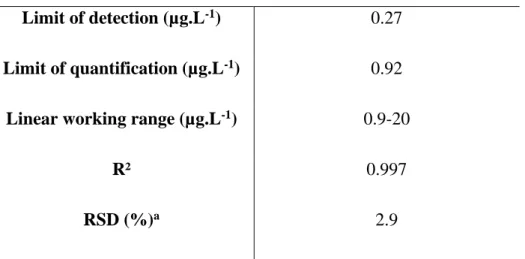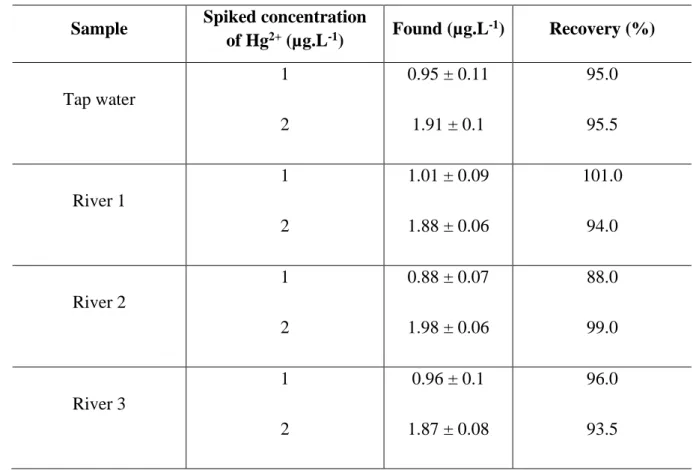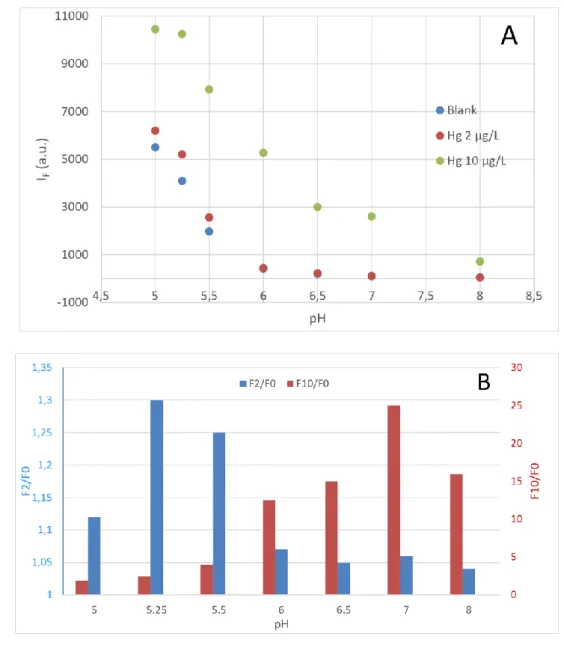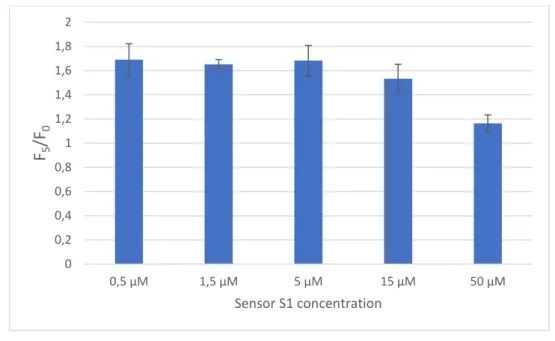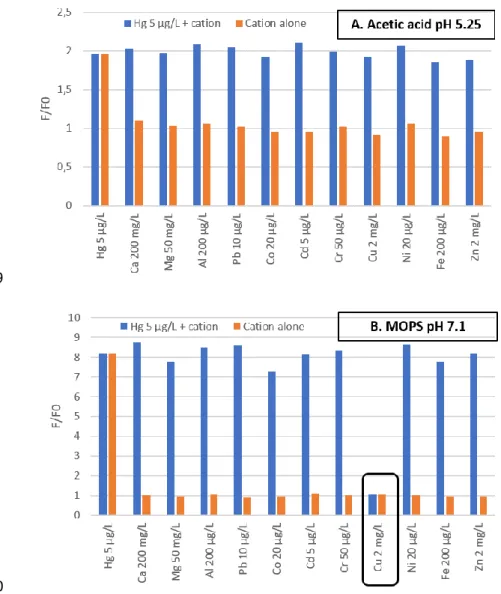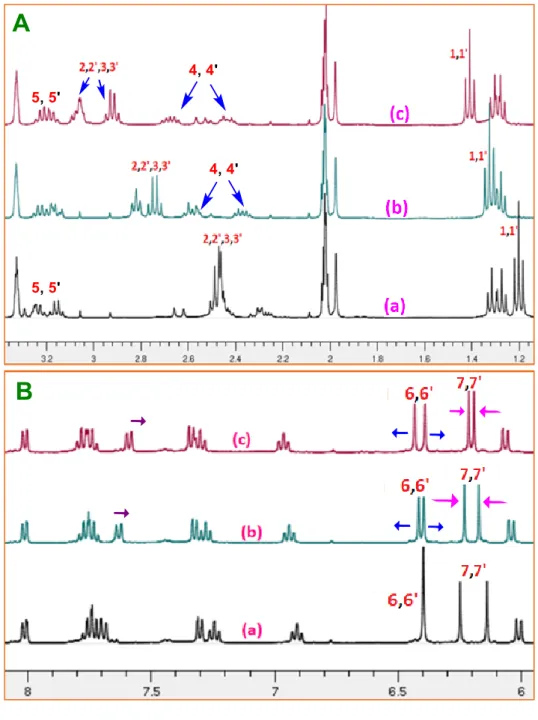HAL Id: hal-03026250
https://hal-amu.archives-ouvertes.fr/hal-03026250
Submitted on 26 Nov 2020HAL is a multi-disciplinary open access archive for the deposit and dissemination of sci-entific research documents, whether they are pub-lished or not. The documents may come from teaching and research institutions in France or abroad, or from public or private research centers.
L’archive ouverte pluridisciplinaire HAL, est destinée au dépôt et à la diffusion de documents scientifiques de niveau recherche, publiés ou non, émanant des établissements d’enseignement et de recherche français ou étrangers, des laboratoires publics ou privés.
Sub-ppb mercury detection in real environmental
samples with an improved Rhodamine-based detection
system
Sukhdev Singh, Bruno Coulomb, Jean-Luc Boudenne, Damien Bonne,
Frédéric Dumur, Bertrand Simon, F. Robert-Peillard
To cite this version:
Sukhdev Singh, Bruno Coulomb, Jean-Luc Boudenne, Damien Bonne, Frédéric Dumur, et al.. Sub-ppb mercury detection in real environmental samples with an improved Rhodamine-based detection system. Talanta, Elsevier, 2021, pp.121909. �10.1016/j.talanta.2020.121909�. �hal-03026250�
1
Sub-ppb mercury detection in real environmental samples with an
1improved Rhodamine-based detection system
2Sukhdev Singh2, Bruno Coulomb1, Jean-Luc Boudenne1, Damien Bonne2, Frédéric Dumur3,
3
Bertrand Simon4, Fabien Robert-Peillard1*
4
1Aix Marseille Univ, CNRS, LCE, Marseille, France 5
2Aix Marseille Université, CNRS, Centrale Marseille, iSm2, Marseille, France 6
3Aix Marseille Univ, CNRS, ICR, UMR 7273, F-13397 Marseille France 7
4Institut d'Optique & CNRS, Laboratoire Photonique Numérique et Nanoscience, UMR 8
5298, Talence, France 9
10
*Corresponding author: fabien.robert-peillard@univ-amu.fr 11
12
Abstract 13
A new procedure is described for the determination of Hg2+ ions in water samples. A
14
Rhodamine based fluorescent sensor was synthesized and the experimental conditions were
15
specifically optimized for application to environmental samples, which requires low detection
16
limits and high selectivity in competitive experiments with realistic concentrations of other
17
metal ions. Incorporation of a Rhodamine-6G fluorophore to a previously described sensor and
18
optimization of the buffer system (detection with acetic acid at pH 5.25) enabled significant
19
enhancement of the sensitivity (detection limit = 0.27 µg.L-1) and selectivity. The optimized
20
procedure using high-throughput microplates has been applied to tap and river waters with good
21
results.
22
Keywords: Fluorescent sensor; Mercury ion; Rhodamine derivative; Water analysis. 23
24
1. Introduction 25
Mercury is one of the most toxic metals found in the environment, with well-known deleterious
26
effects on kidneys, liver and the central nervous system which leads to various cognitive and
2
motor disorders [1,2]. Among mercury species, the Hg2+ ion has been extensively studied
28
because it can be biomethylated into methyl mercury in the environment [3]. Conventional
29
methods for analysis of mercury in laboratories include cold vapor atomic absorption
30
spectroscopy and inductively coupled plasma mass spectrometry, which are either expensive or
31
complex analytical techniques. Methods based on fluorescent sensors have gained considerable
32
attention in the past years, due to the simplicity of the operations combined to high selectivity
33
and sensitivity of the designed sensors.
34
Fluorescent sensors based on organic dyes are particularly suited for the analysis of Hg2+ ion
35
and other cations [4-6]. This type of sensor includes an ion recognition unit (ionophore) which
36
triggers modification of the fluorescence features of an organic fluorophore. Among these
37
fluorophores, the rhodamine framework has appeared as the ideal choice, due to the high
38
fluorescence quantum yields obtained by the spirolactam cycle opening and the ease of
39
structural modification for the ionophore part. Consequently, several Rhodamine-based
40
molecular sensors for Hg2+ have been described in the literature [7].
41
However, most of these sensors have not convincingly demonstrated their capacities to be
42
applied to the analysis of real environmental waters (tap water, natural waters). To fulfill
43
requirements for these types of analysis, the sensor has to: i) detect mercury in aqueous media;
44
ii) reach high sensitivity with quantification limits below the µg.L-1 range (the parametric value
45
for the quality of water intended for human consumption in Europe is 1 µg.L-1 and the maximal
46
allowable concentration in inland waters has been established to 0.05 µg.L-1 by European
47
Union); iii) prove the selectivity for Hg2+ in the presence of very large excess of some other
48
naturally occurring ions (especially Ca2+ or Cu2+). Regarding application to aqueous sample,
49
rhodamine-based sensors displaying interesting analytical features only in organic or mixed
50
organic-aqueous media will not be efficient [8,9]. Likewise, many sensors have detection limits
51
which are either not indicated or in the 10-8-10-6 M range (2-200 µg.L-1) [10-12], which is not
3
enough sensitive for real samples like tap water or natural waters. Selectivity for Hg2+ is almost
53
always demonstrated by competitive experiments with 1-10 equivalents of other metal ions
54
compared to mercury [10, 12-16], which is not representative of real environmental samples.
55
Application of Rhodamine fluorescent sensors is thus generally limited to the fluorescence
56
imaging of Hg2+ in cells. Only one application to real water samples has been documented by
57
Pan et al. with the determination of Hg2+ in industrial wastewaters in the µM range (150-250
58
µg.L-1) [17]. Description of a rhodamine sensor designed for tap or natural water analysis is
59
thus highly needed.
60
Among rhodamine sensors, NS2 ionophore described by Huang et al. [15] seemed particularly
61
suited for aqueous application with high selectivity for Hg2+. In the present study we
62
synthesized the rhodamine B sensor (sensor S2, Fig. 1) described by Huang et al. [15].
63
However, the first experiments using their experimental conditions led us to conclude that the
64
sensitivity seemed too low for application to environmental water samples. We thus decided to
65
modify that sensor by incorporation of a rhodamine-6G fluorophore group (sensor S1) and to
66
investigate analytical parameters in order to reach low µg.L-1 detection limit for application to
67
real water samples. Experiments were performed in microplates to take advantage of the
high-68
throughput screening properties of this type of analytical tool, ideal for optimization purposes.
69
Results of these optimizations are reported in this work.
70 71
2. Material and methods 72
73
2.1.Chemicals and reagents
74
Rhodamine-6G (Dye content: 95%), HEPES (4-(2-Hydroxyethyl)piperazine-1-ethanesulfonic
75
acid), MOPS (3-(N-Morpholino)propanesulfonic acid) and acetic acid were purchased from
4
Sigma-Aldrich (France). Ultrapure water purified with a Milli-Q system (Millipore, USA,
77
resistivity >18 MΩ cm) was used for the preparations of the whole solutions.
78
A 1 mg.L-1 Hg2+ stock solution was prepared daily in a glass vial [18] by dilution of a 1 g.L-1
79
standard solution (AAS grade, Sigma Aldrich) with ultrapure water and a few drops of NaOH
80
0.1 M solution to set pH of the stock solution between 3.5-4. The same protocol was applied
81
for the other heavy metal stock solutions used for the selectivity study.
82
5 mM stock solutions of sensors were prepared in DMSO and stored at +4° C (stable for at least
83
2 months). The stock solution was then diluted in ultrapure water to give a 5 µM working
84
solution (1 ‰ DMSO), which was stable for at least 2 weeks in the fridge.
85
The tap water sample was collected in the laboratory (Marseille, France). River water samples
86
were collected from the Huveaune (River 1: Roquevaire, France; River 2: Aubagne, France)
87
and the Arc (River 3: Ventabren, France), filtered on 0.45 µm PES filters and stored at +4° C
88
until analysis. pH of the spiked samples was set between 5.2 and 5.3 with diluted HNO3 to
89
avoid pH variation after addition of acetic acid buffer.
90 91
2.2.Synthesis of sensor S1 and S2
92
The sensors S1 was synthesized by a simple modified procedure starting from rhodamine-6G
93
base (1) (Scheme 1, see supporting information for detailed procedure). The rhodamine-6G
94
base 1 was reacted with ionophore NS2 in the presence of 4-toluenesulfonyl chloride (TsCl)
95
and 4-dimethylaminopyridine (DMAP) in dry dichloromethane at room temperature for 4 h and
96
sensor S1 was obtained in 47% yield as a light pink/beige color solid. 1H NMR (400 MHz,
97
CDCl3) δ 8.05-8.00 (m, 1H), 7.62-7.55 (m, 3H), 7.27-7.22 (m, 1H), 7.14 (td, 1H, J = 7.6 Hz,
98
1.4 Hz), 6.84 (td, J = 7.7 Hz, 1.7 Hz), 6.34 (d, 2H, J = 5.4 Hz), 6.21 (s, 1H), 6.10 (s, 1H), 5.94
5 (dd, 1H, J = 8.0 Hz, 1.4 Hz), 3.53 and 3.45 (2 x s, 2H), 3.34 (d, 1H, J = 15.8 Hz), 3.23-3.03 (m, 100 4H), 2.62 (d, 1H, J = 15.7 Hz), 2.48-2.31 (m, 10H), 2.29-2.19 (m, 2H), 1.96 and 1.93 (2 x s, 101 6H), 1.33-1.22 (m, 6H), 1.15 (t, 6H, J = 7.4 Hz). 13C NMR (100 MHz, CDCl 3) δ 166.09, 153.49, 102 152.93, 151.54, 147.81, 139.80, 133.86, 132.88, 132.80, 129.75, 128.80, 128.70, 128.62, 103 128.18, 128.12, 126.48, 124.73, 123.61, 120.96, 118.12, 117.19, 108.45, 107.22, 96.88, 96.67, 104 68.54, 54.52, 54.43, 38.61, 38.49, 30.11, 27.13, 26.22, 17.19, 17.02, 15.01, 14.86. HRMS (EI): 105
Calculated for C41H51N4O2S2 [M+H]+ 695.3448; found: 695.3445.
106
Sensor S2 was also synthesized using similar procedure as adopted for sensor S1 starting with
107
rhodamine-base B (2) and ionophore NS2. With this method, sensor S2 was obtained as a beige
108
color solid with improved 65% yield as compared to previously reported yield of 26% [15] (see
109
supplementary data for detailed procedure and NMR data).
110 111
2.3. Instrumentation
112
Fluorescence spectra of sensor S1 and sensor S2 were recorded on a SAFAS Xenius
113
spectrofluorometer (Monaco) equipped with a Xenon lamp and controlled by SP2000 V7
114
software (SAFAS). Microplate fluorescence measurements were carried out on a microplate
115
reader (Infinite M200, Tecan France SAS, Lyon, France) equipped with an excitation and
116
emission double monochromator (bandwidths of 9 nm and 20 nm for excitation and emission
117
monochromator, respectively) and controlled by i-control™ software (Tecan). Fluorescence
118
detection was performed from above the microplate wells (top configuration), at λex = 540 nm
119
and λem = 575 nm. Operating temperature was set to 25 °C. Other parameters were as follows:
120
gain: 180; number of flashes: 50; integration time: 20 µs. Fluorescence intensities were
121
expressed in arbitrary units (a.u.). Polypropylene black 96 well U-bottom microplates (Nunc),
122
with a maximum capacity of 500 µL for each well were used.
6
2.4. General microplate procedure
124
300 µL of sample or Hg2+ standard solution were dispensed into the wells of the microplate,
125
followed by 50 µL of the buffer solution and 30 µL of the 5 µM working solution of sensor S1.
126
The plate was shaken for 3 min in the microplate reader, and fluorescence was subsequently 127
measured at λex = 540 nm and λem = 575 nm. All experiments were performed in duplicate.
128 129
3. Results and discussion.
130
3.1. Optimization of experimental conditions
131
3.1.1. Fluorescence response of S1 and S2 at pH 7
132
The publication from Huang et al. [15] studying S2 used HEPES buffer at pH 7 (with 15%
133
MeCN). Our first experiments with S1 and S2 displayed a negative influence of MeCN on the
134
fluorescent response, so we decided to compare the response of the sensors only in pure aqueous
135
solution. Our analytical protocol used a large volume of sample and addition of a small volume
136
of buffer and sensor, to optimize the analytical performances of the protocol. Standard solutions
137
of 1 mg.L-1 Hg2+ were neutralized at pH around 4 (starting from stock solution in 5% HNO 3) in
138
order to avoid variation of pH between blank and standard solutions. Fluorescence emission
139
spectra recorded on a traditional spectrofluorometer are displayed on Figure 2. As expected,
140
emission wavelength (565 nm) for S1 with Rhodamine-6G base is lower than S2 (595 nm) with
141
Rhodamine B base [10]. S1 also already showed superior performances at low concentrations,
142
with a fluorescence response at 10 µg.L-1 much better than S2 (see inset of Fig. 2). We thus
143
decided to focus on the new sensor with Rhodamine-6G for the optimization of the experimental
144
conditions.
145
3.1.2. Influence of the pH buffer
7
Most publications study the fluorescence response of the sensors at high concentrations of the
147
metal cation targeted (1-10 µM = 200-2000 µg.L-1). Our aim was to develop a simple microplate
148
protocol that could be used at low mercury concentrations more consistent with environmental
149
conditions (linear range up to 10 µg.L-1, detection limit below 1 µg.L-1), so we first studied the
150
influence of the pH on 10 µg.L-1 and 2 µg.L-1 standard solutions. High-throughput microplates
151
and a microplate reader were used for all the optimization tests. Results for various pH are
152
presented on Figure 3 (MOPS was used at pH 7 with similar results as HEPES, with better
153
buffer capacity for MOPS than HEPES at pH 7). Interestingly, evolution of the fluorescence
154
response of the sensor is completely different at pH 5.25 compared to pH 7. While ratio between
155
fluorescence response of a 10 µg.L-1 and a blank solution is much better at pH 7, results are
156
completely opposite for the 2 µg.L-1 standard solution. In fact, only slightly acidic conditions
157
(pH 5-5.5) can enable actual detection of standard solution of Hg2+ below 2 µg.L-1 with S1.
158
Buffers with pH below 5 displayed lower response with both standard solutions.
159
3.1.3. Influence of the sensor concentration
160
While better results with low concentration of sensor could be anticipated to improve sensitivity
161
and detection limit [10], our experiments with S1 did not display a sharp effect when sensor
162
concentration was lowered (Fig. 4). Results were similar in the range 0.5-5 µM but choosing a
163
too low sensor concentration to optimize detection limit could be detrimental for selectivity in
164
presence of other metal cations and both analytical aspects have to be taken into account when
165
one optimize a protocol for application to real environmental samples. We thus decided to keep
166
5 µM as the optimal concentration value for the rest of the study.
167
3.1.4. Characterization of the complex between S1 and Hg2+
168
Regarding stoichiometry of the complex between S1 and Hg2+, the Job’s Plot depicted in Figure
169
S1 (for sensor S1 at pH 5.25) proved the same 1:1 stoichiometry as sensor S2 at pH 7 [15]. This
8
was also confirmed by ES(+)-HRMS of a mixture of S1 and Hg2+ (Fig. S9, supplementary data),
171
with a peak at 931.3174 assigned to the single-charged complex [S1 + Hg2+ + Cl-]+. To further
172
confirm the coordination of Sensor S1 with Hg2+, 1H-NMR experiments were done. As shown
173
in Figure S10 (supplementary data), the triplet peaks centered at 1.20 corresponding to methyl
174
groups (1 and 1’), shifted downfield to 1.41 (∆δ = 0.21 ppm) upon addition of 1 equiv of Hg2+
175
to the sensor S1. This shift was attributed to the coordination of sulphur “S” with Hg2+.
176
Moreover, the quartets and triplets associated with protons 2, 2’, 3 and 3 also shifted to the
177
downfield region of the spectra. The triplets due to the methylene groups attached nitrogen of
178
ionophore part (4 and 4’) also shown the shifts towards downfield region of the spectra which
179
indicated the involvement of “N” in coordination with Hg2+. The aromatic protons of
180
rhodamine, specially H6, H6’, H7 and H7’ also shown the clear changes in their chemical shifts
181
due to the shifting of the aromatic bonds (delocalization) that trigger opening of spirolactone
182
upon complexation with Hg2+. Based on combined results of NMR and HRMS analysis, we
183
could propose the mode of coordination of sensor S1 with Hg2+ as described in scheme S5
184
(supplementary data) where both sulphur “S” and “N” of ionophore part, and “O” of carbonyl
185
are involved in the interaction with Hg2+.
186 187
3.2. Analytical performances of sensor S1
188
3.2.1. Comparison of the detection limit of S1 and S2
189
Detection limits for S1 and S2 (calculated as 3σb/s; σb is the standard deviation of the blank
190
signals with n=10, and s the slope of the calibration curve) were compared for various
191
experimental conditions (Table 1). The first tests were carried out following the conditions
192
described by Huang et al. for S2 (with 15% acetonitrile). In our experiments, acetonitrile was
193
not necessary for solubility purposes using the sensor concentration described (25 µL of a 5 µM
9
sensor solution, corresponding to 0.33 µM in the mixture with sample and buffer; Solutions of
195
S1 at 5 µM are stable in the fridge at least for 2 weeks after dilution of a 5 mM stock solution 196
in DMSO). At pH 7.1 and 5.25, sensor S1 could detect mercury at concentrations 3.5 times
197
lower than S2, proving that rhodamine-6G base is better than rhodamine B for this type of
198
sensor (Table 1). To the best of our knowledge, this study is the first report which compares the
199
influence of the rhodamine fluorophore (with the same ionophore) on the sensitivity of a sensor.
200
An excellent detection limit of 0.3 µg.L-1 (1.5 nM) could be obtained with acetic acid buffer,
201
proving high sensitivity of the new sensor with the optimized experimental parameters. Overall,
202
detection limits using this type of rhodamine sensor have been improved 175 times compared
203
to conditions described before using S2.
204
Experimental conditions S1 S2
MeCN/HEPES 20 mM pH 7 (15/85)a 19 µg.L-1 53 µg.L-1
MOPS 50 mM pH 7.1b 2.0 µg.L-1 7.1 µg.L-1
Acetic acid 50 mM pH 5.25b 0.27 µg.L-1 1.1 µg.L-1
a. In the final mixture; b. Buffer added to the sample (50 µL buffer for 300 µL sample).
205
Table 1. Detection limits obtained with S1 and S2 using different conditions with the microplate
206
protocol. Detection wavelengths for S1: λexc = 535 nm; λem = 570 nm; for S2: λexc = 540 nm;
207
λem = 595 nm.
208
3.2.2. Analytical features for sensor S1
209
The analytical procedure with sensor S1 was evaluated using the optimized experimental
210
conditions (Table 2). Very good linear regression coefficient was obtained in the range 0.9-20
211
µg.L-1 (Fig S2), with excellent RSD value proving repeatability of our measurements. The limit
212
of quantification is below 1 µg.L-1, which is the parametric value for the quality of water
10
intended for human consumption in Europe [19]. The protocol can thus be implemented for this
214
kind of samples regarding the European legislation.
215
Limit of detection (µg.L-1) 0.27
Limit of quantification (µg.L-1) 0.92
Linear working range (µg.L-1) 0.9-20
R² 0.997
RSD (%)a 2.9
a. Calculated on a 5 µg.L-1 standard, n= 6 replicates 216
Table 2. Analytical features of the microplate protocol with S1. Buffer: Acetic acid 50 mM pH
217
5.25.
218
3.2.3. Selectivity study
219
Selectivity of a sensor for a metal ion is crucial for application to real samples. This is
220
particularly important for mercury ion in environmental samples, with mercury concentration
221
in the nM range, while other metal ions could be present up to a few tens of µM (Cu2+, Zn2+) or
222
in the mM range (Ca2+, Mg2+). Most publications describe their selectivity study with µM
223
concentration of Hg2+ and 10 equivalents of other metal ion, which are experimental hypothesis
224
clearly not suitable for environmental samples. For this study, we chose Hg2+ at 5 µg.L-1 (25
225
nM) in order to obtain a significant response with good repeatability. Concentrations of other
226
metal ions were chosen based on parametric values defined by the European legislation on water
227
intended for human consumption (Cu2+, Pb2+, Cd2+). For metal ions not listed in this legislation,
228
we chose high concentrations that should not be exceeded in a surface water (Ca2+, Mg2+, Zn2+).
229
Response was studied first with each metal ion separately and then under competitive
230
conditions with mercury ion at 5 µg.L-1 (Fig. 5). We also compared our optimized experimental
11
conditions (acetic acid buffer pH 5.25, Fig. 5A) with usual conditions used for this type of
232
sensor (buffer at pH 7, Fig. 5B). The tolerance limit was ± 5% change between the fluorescence
233
of Hg2+ alone and the fluorescence in presence of interfering ions at the maximal concentration
234
chosen. Results display excellent selectivity of sensor S1, even in competitive experiments with
235
other metal ions in real environmental concentrations (the tolerance limit was not exceeded for
236
all metal ions studied). Interestingly for our study, the same experiment at neutral pH
237
(conditions described by previous group studying sensor S2) gives strong interference of copper
238
ions, completely inhibiting response of sensor S1 with mercury ions. The same results were
239
found with HEPES buffer. pH is thus an important parameter in our procedure to avoid
240
interference from copper ions. Study from Huang et al. with sensor S2 did not exhibit this
241
interference from copper at pH 7, probably because copper was only five times in excess
242
compared to mercury [15]. We can thus conclude that using realistic metal ions concentrations
243
is clearly necessary to study selectivity and optimize analytical conditions of a new sensor for
244
real life application, especially in the environmental field.
245
3.2.4. Comparison with other rhodamine sensors
246
Sensors for mercury detection can be based on rhodamine, fluorescein, coumarin or dansyl
247
organic dyes [5]. Among them, rhodamine sensors gives the best analytical performances, and
248
we thus decided to compare our sensor S1 with other rhodamine sensors described for
249
applications in aqueous media (Table 3). From this comparison, we can conclude that sensor
250
S1 is the only sensor for which sensitivity and selectivity have been demonstrated for 251
application to real natural water samples.
252 253 254
12
Ref LOD (µg.L-1) Selectivity
17 4.6 Demonstrated with 1 eq of interferent ions
20 14.8 Interference of Fe
3+, others demonstrated with 5 eq of
interferents ions
21 136 Demonstrated with 30 eq of interferent ions
12 470 Demonstrated with 1 eq of interferent ions
13 0.5 Interference of Zn
2+, others demonstrated with 5 eq of
interferents ions
16 0.3 Demonstrated with 1 eq of interferent ions
10 0.6 Demonstrated with 5 eq of interferent ions
This work 0.27
Demonstrated with concentration of interferent ions relevant with the analysis of natural water samples (up to 1000 eq for
Cu2+ and 200.000 eq for Ca2+)
Table 3. Comparative study of rhodamine-based sensor for Hg2+ analysis in aqueous media.
255 256
3.3. Test with real samples
257
Our optimized protocol was then applied to four real water samples (one tap water and three
258
river samples) to assess the potential of our analytical procedure. Most publications related to
259
mercury sensors describe application to quantify Hg2+ levels in living cells, with incubation
260
levels at 20-40 µg.L-1 (100-200 nM) [10,11]. Application to environmental samples like natural
261
waters requires lower levels of study. As our selected samples contained no mercury (checked
262
by ICP-MS analysis), samples were spiked at 1 µg.L-1 (5 nM) and 2 µg.L-1 (10 nM) of mercury.
263
As pH control is important for our protocol (use of an acetic acid buffer at pH 5.25), pH of the
264
real samples was set between 5.2 and 5.3 after spiking. Results for the spiked samples show
265
that good recoveries were achieved (Table 4), demonstrating that our protocol can be applied
13
to real water samples, even at the µg.L-1 level which is the parametric value for the quality of
267
water intended for human consumption in Europe.
268 269 270
Sample Spiked concentration
of Hg2+ (µg.L-1) Found (µg.L -1) Recovery (%) Tap water 1 2 0.95 ± 0.11 1.91 ± 0.1 95.0 95.5 River 1 1 2 1.01 ± 0.09 1.88 ± 0.06 101.0 94.0 River 2 1 2 0.88 ± 0.07 1.98 ± 0.06 88.0 99.0 River 3 1 2 0.96 ± 0.1 1.87 ± 0.08 96.0 93.5
Table 4. Detection of Hg2+ in spiked real water samples using the microplate protocol. Buffer:
271 Acetic acid 50 mM pH 5.25. 272 273 4. Conclusions 274
In conclusion, this study has proven that simple optimizations of a metal ion detection method
275
can result in large enhancement of the analytical performances, required for reliable application
276
to real samples. Replacing rhodamine-B fluorophore by rhodamine-6G on our NS2-containing
277
sensor improved detection limits more than 3-fold. Optimization of the buffer used for detection
278
of Hg2+ ion displayed significant effects both on detection limits and selectivity. Acetate buffer
14
enabled detection of Hg2+ below 1 µg.L-1 (LOD = 0.3 µg.L-1), whereas traditional neutral
280
buffers were limited at 2 µg.L-1. Use of acetate buffer also circumvented the problem of copper
281
in competitive experiments, which is a very common issue related to copper as a general
282
fluorescent quencher [22]. The optimized procedure has been successfully applied to real water
283
samples, demonstrating applicability of our new methodology for Hg2+ detection.
284 285
Acknowledgements 286
The project leading to this publication has received funding from the French Research Agency
287
(project « SMART-3D », ANR-18-CE04-0005). Financial support from Aix-Marseille
288
Université, the Centre National de la Recherche Scientifique (CNRS), and Centrale Marseille
289
is also gratefully acknowledged.
290 291
References 292
[1] C. M. L. Carvalho, E.-H. Chew, S. I. Hashemy, J. Lu, A. Holmgren, Inhibition of the human
293
thioredoxin system, a molecular mechanism of mercury toxicity, J. Biol. Chem. 283 (2008)
294
11913-11923. https://doi.org/10.1074/jbc.M710133200.
295
[2] G.Bjørklund, M. Dadar, J. Mutter, J. Aaseth, The toxicology of mercury: Current research
296
and emerging trends, Environ. Res. 159 (2017) 545-554.
297
https://doi.org/10.1016/j.envres.2017.08.051
298
[3] A. Manceau, M. Enescu, A. Simionovici, M. Lanson, M. Gonzalez-Rey, M. Rovezzi, R.
299
Tucoulou, P. Glatzel, K. L. Nagy, J.-P. Bourdineaud, Chemical forms of mercury in human hair
300
reveal sources of exposure, Environ. Sci. Technol. 50 (2016) 10721-10729.
301
https://doi.org/10.1021/acs.est.6b03468.
302
[4] T. Rasheed, M. Bilal, F. Nabeel, H. M.N. Iqbal, C. Li, Y. Zhou, Fluorescent sensor based
303
models for the detection of environmentally-related toxic heavy metals, Sci. Total Environ. 615
304
(2018) 476-485. https://doi.org/10.1016/j.scitotenv.2017.09.126.
15
[5] N. De Acha, C. Elosúa, J. M. Corres, F. J. Arregui, Fluorescent sensors for the detection of
306
heavy metal ions in aqueous media, Sensors 19 (2019) 599.https://doi.org/10.3390/s19030599.
307
[6] H. M. Al-Saidi, A. A. El-Bindary, A. Z. El-Sonbati, M. A. Abdel-Fadeel, Fluorescence
308
enhancement of rhodamine B as a tool for the determination of trace and ultra-trace
309
concentrations of bismuth using dispersive liquid–liquid microextraction, RSC Adv. 6 (2016)
310
21210-21218. https://doi.org/10.1039/c5ra27764g
311
[7] G. Chen, Z. Guo, G. Zeng, L. Tanga, Fluorescent and colorimetric sensors for environmental
312
mercury detection, Analyst 140 (2015) 5400-5443. https://doi.org/10.1039/c5an00389j.
313
[8] M. H. Lee, J.-S. Wu, J. W. Lee, J. H. Jung, J. S. Kim, Highly sensitive and selective
314
chemosensor for Hg2+ based on the rhodamine fluorophore, Org. Lett. 9 (2007) 2501-2504.
315
https://doi.org/10.1021/ol0708931.
316
[9] D. Wu, W. Huang, C. Duan, Z. Lin, Q. Meng, Highly sensitive fluorescent probe for
317
selective detection of Hg2+ in DMF aqueous media, Inorg. Chem 46 (2007) 1538-1540.
318
https://doi.org/10.1021/ic062274e.
319
[10 ] Y.-J. Gong, X.-B. Zhang, Z. Chen, Y. Yuan, Z. Jin, L. Mei, J. Zhang, W. Tan, G.-L. Shen,
320
R.-Q. Yu, An efficient rhodamine thiospirolactam-based fluorescent probe for detection of Hg2+
321
in aqueous samples, Analyst 137 (2012) 932–938. https://doi.org/10.1039/C2AN15935J
322
[11] M. De la Cruz-Guzman, A. Aguilar-Aguilar, L. Hernandez-Adame, A. Bañuelos-Frias,
323
F. J Medellín-Rodríguez, G. Palestino, A turn-on fluorescent solid-sensor for Hg(II) detection,
324
Nanoscale Res. Lett. 9 (2014) 1-9. https://doi.org/10.1186/1556-276X-9-431.
325
[12] M. Li, Y. Sun, L. Dong, Q.-C. Feng, H. Xu, S.-Q. Zang, T. C.W. Mak, Colorimetric
326
recognition of Cu2+ and fluorescent detection of Hg2+ in aqueous media by a dual chemosensor
327
derived from rhodamine B dye with a NS2 receptor, Sens. Actuat. B – Chem. 226 (2016)
332-328
341. https://doi.org/10.1016/j.snb.2015.11.132.
329
[13] W. Huang, C. Song, C. He, G. Lv, X. Hu, X. Zhu, C. Duan, Recognition preference of
330
rhodamine-thiospirolactams for Mercury(II) in aqueous solution, Inorg. Chem. 48 (2009)
5061-331
5072. https://doi.org/10.1021/ic8015657.
332
[14] W. Lin, X. Cao, Y. Ding, L. Yuan, Q. Yu, A reversible fluorescent Hg2+ chemosensor
333
based on a receptor composed of a thiol atom and an alkene moiety for living cell fluorescence
16
imaging, Org. Biomol. Chem. 8 (2010) 3618-3620. https://doi.org/10.1039/C0OB00081G.
335
[15] J. Huang, Y. Xu, X. Qian, A Rhodamine-based Hg2+ sensor with high selectivity and
336
sensitivity in aqueous solution: a NS2-containing receptor, J. Org. Chem. 74 (2009) 2167-2170.
337
https://doi.org/10.1021/jo802297x.
338
[16] J. Gong, C. Liu, X. Jiao, S. He, L. Zhao and X. Zeng, A novel near-infrared fluorescent
339
probe with improved Stokes shift for specific detection of Hg2+ in mitochondria, Org. Biomol.
340
Chem. 18 (2020) 5238-5244. https://doi.org/10.1039/D0OB00507J
341
[17] F. Pan, J. Mao, Q. Chen, P. Wang, Solid-phase extraction of mercury(II) with magnetic
342
core-shell nanoparticles, followed by its determination with a rhodamine-based fluorescent
343
probe, Microchim. Acta 180 (2013) 1471-1477. https://doi.org/10.1007/s00604-013-1084-6
344
[18] J. L. Parker, N. S. Bloom, Preservation and storage techniques for low-level aqueous
345
mercury speciation, Sci. Total Environ. 337 (2005) 253-263.
346
https://doi.org/10.1016/j.scitotenv.2004.07.006
347
[19] ANNEXES to the Proposal for a Directive of the European Parliament and of the Council
348
on the quality of water intended for human consumption (recast), European Commission,
349 COM(2017) 753 final 2017/0332. 350 https://eur-lex.europa.eu/resource.html?uri=cellar:8c5065b2-074f-11e8-b8f5-351 01aa75ed71a1.0016.02/DOC_2&format=PDF 352
[20] F. Yan, D. Cao, M. Wang, N. Yang, Q. Yu, L. Dai, L. Chen, A New Rhodamine-Based
353
“Off-On” Fluorescent Chemosensor for Hg (II) Ion and its Application in Imaging Hg (II) in
354
Living Cells, J. Fluoresc. 22 (2012) 1249-1256. https://doi.org/10.1007/s10895-012-1065-x
355
[21] X. Li, R. Zhao, Y. Wei, D. Yang, Z. Zhou, J. Zhang, Y. Zhou, A rhodamine derivative for
356
Hg2+-selective colorimetric and fluorescent sensing and its application to in vivo imaging, Chin.
357
Chem. Lett. 27 (2016) 813-816. https://doi.org/10.1016/j.cclet.2016.04.001
358
[22] S. Mizukami, T. Nagano, Y. Urano, A. Odani, K. Kikuchi, A fluorescent anion sensor that
359
works in neutral aqueous solution for bioanalytical application, J. Am. Chem. Soc. 124 (2002)
360 3920-3925. https://doi.org/10.1021/ja0175643. 361 362 363 364
17 Figure captions
365
Figure 1. Structure of sensors S1 and S2.
366
Figure 2- Fluorescence emission spectra of sensors S1 and S2 in the presence of different
367
concentrations of Hg2+. Excitation was performed at 535 nm. Protocol: 1 mL sample + 150 µL
368
HEPES buffer 50 mM pH 7.0 + 100 µL sensor 5 µM, shaking for 3 min. Inset: Zoom for
369
fluorescence intensity between 0 and 10.
370
Figure 3- Comparison of the response of S1 with two standard solutions, depending on the
371
buffer. Microplate protocol. Buffer: Acetic acid 50 mM for pH 5-5.5; MES 50 mM for pH
6-372
6.5; MOPS 50 mM for pH 7-8. (A) Fluorescence intensities; (B) Ratio of fluorescence intensities
373
between standard solutions and blank (F2/F0: ratio Hg 2 µg.L-1/blank; F10/F0: ratio Hg 10
374
µg.L-1/blank).
375
Figure 4- Influence of the sensor S1 concentration on the fluorescence response. Microplate
376
protocol. Sensor concentration is the concentration in the 25 µL of sensor added to the sample.
377
Buffer: Acetic acid 50 mM pH 5.25. F5/F0 is the ratio between the fluorescence response of a 5
378
µg.L-1 standard solution and the blank.
379
Figure 5. Selectivity study with sensor S1. A. Buffer: Acetic acid 50 mM pH 5.25. B: Buffer:
380
MOPS 50 mM pH 7.1. Microplate protocol, F/F0 is the ratio between the fluorescence response
381
of the metal ions solution and the blank.
382
Scheme 1. Synthesis of Sensor S1
383 384 385 386 387
18 388
Figure 1. Structure of sensors S1 and S2 389
390
391
392
Figure 2. Fluorescence emission spectra of sensors S1 and S2 in the presence of different 393
concentrations of Hg2+. Excitation was performed at 535 nm. Protocol: 1 mL sample + 150 µL
394
HEPES buffer 50 mM pH 7.0 + 100 µL sensor 5 µM, shaking for 3 min. Inset: Zoom for
395
fluorescence intensity between 0 and 10
19 397
398
Figure 3. Comparison of the response of S1 with two standard solutions, depending on the 399
buffer. Microplate protocol. Buffer: Acetic acid 50 mM for pH 5-5.5; MES 50 mM for pH
6-400
6.5; MOPS 50 mM for pH 7-8. (A) Fluorescence intensities; (B) Ratio of fluorescence
401
intensities between standard solutions and blank (F2/F0: ratio Hg 2 µg.L-1/blank; F10/F0: ratio
402
Hg 10 µg.L-1/blank)
20 404
Figure 4. Influence of the sensor S1 concentration on the fluorescence response. Microplate 405
protocol. Sensor concentration is the concentration in the 25 µL of sensor added to the sample.
406
Buffer: Acetic acid 50 mM pH 5.25. F5/F0 is the ratio between the fluorescence response of a 5
407
µg.L-1 standard solution and the blank
408 0 0,2 0,4 0,6 0,8 1 1,2 1,4 1,6 1,8 2 0,5 µM 1,5 µM 5 µM 15 µM 50 µM F5 /F0 Sensor S1 concentration
21 409
410
Figure 5. Selectivity study with sensor S1. A. Buffer: Acetic acid 50 mM pH 5.25. B: Buffer: 411
MOPS 50 mM pH 7.1. Microplate protocol, F/F0 is the ratio between the fluorescence response
412
of the metal ions solution and the blank
22 414
Figure 6. 1H-NMR titration of Sensor S1 (10.0 mM) with Hg2+ in CD3CN and CD3OD (1:1).
415
(a) Sensor S1 only; (b) Sensor S1 + 0.5 equiv of Hg2+ and (c) Sensor S1 + 1.00 equiv of Hg2+
416 417 418 419
23 420
Scheme 1. Synthesis of Sensor S1 421
422
Scheme 2. Proposed mode of complexation of Sensor S1 with Hg2+
423 424 425 426 427 428

